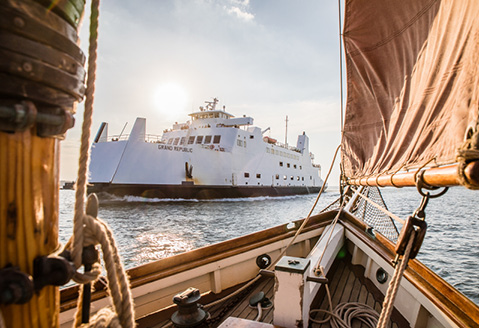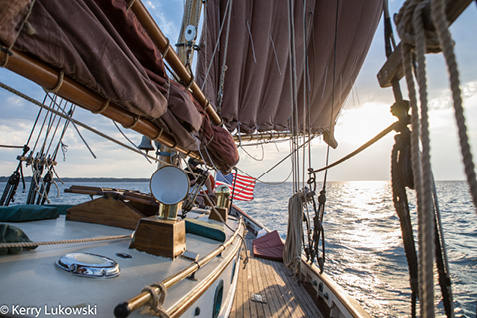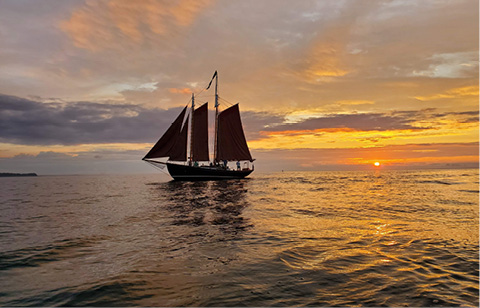By Lon S. Cohen
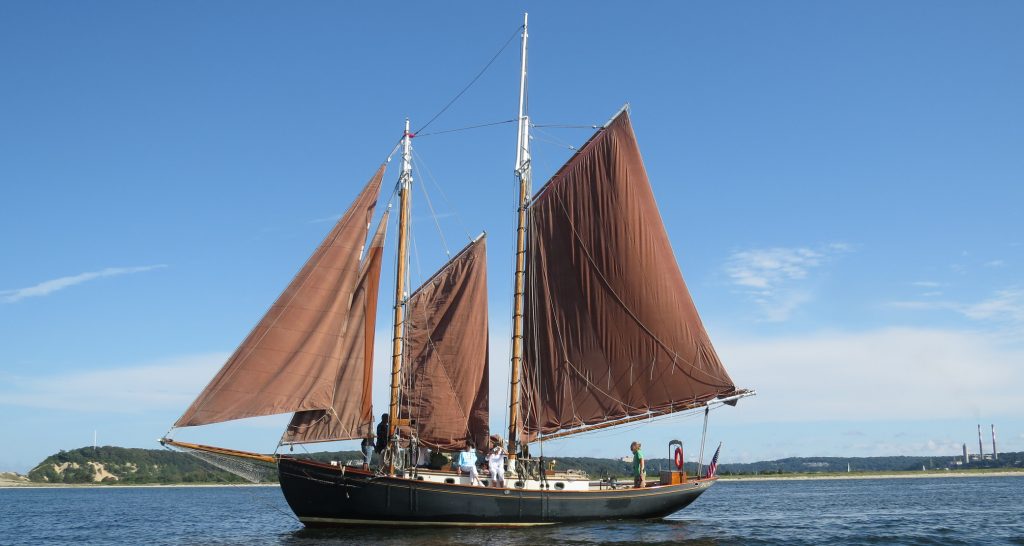
The Ginny Marie, a 50-foot gaff topsail schooner, is available for charter out of Port Jefferson, New York from May to October. © Dave Hubbard
After a career in healthcare, Captain Brian Murphy plunged back into his love of the wind and sea, chartering his 50-foot William Atkins schooner, the Ginny Marie, out of Port Jefferson, NY to anyone who wants to experience old school sailing.
On any day during the sailing season, pedestrians taking a stroll on a pier jutting out from a park in Port Jefferson will inevitably stop and gaze down at the floating dock where the Ginny Marie has berthed for the past two years.
The gaff topsail schooner demands attention with her cinnamon-hued sails, configuration of wooden blocks, hemp lines running through dead eyes, and halyards secured to belaying pins. At the same time, she looks perfectly at home in the progressive developing harbor that cherishes its shipbuilding history. She’s a piece of the puzzle that fits snugly into the larger picture of Port Jefferson, a working waterfront where the ferries pass by the hour heading to Connecticut and tugs push stone-laden freight ships into port.
Ginny Marie is docked just east of Danfords Hotel & Marina, a mere stone’s throw from the well-worn ways, twin iron beams embedded into the ground of the aptly named Harborfront Park where for generations, shipbuilders launched their newly-built vessels into the harbor with a great splash.
“You like to sail?” Captain Brian Murphy will yell up to the looky loos, smiling and waving them down. “Come, check her out.”
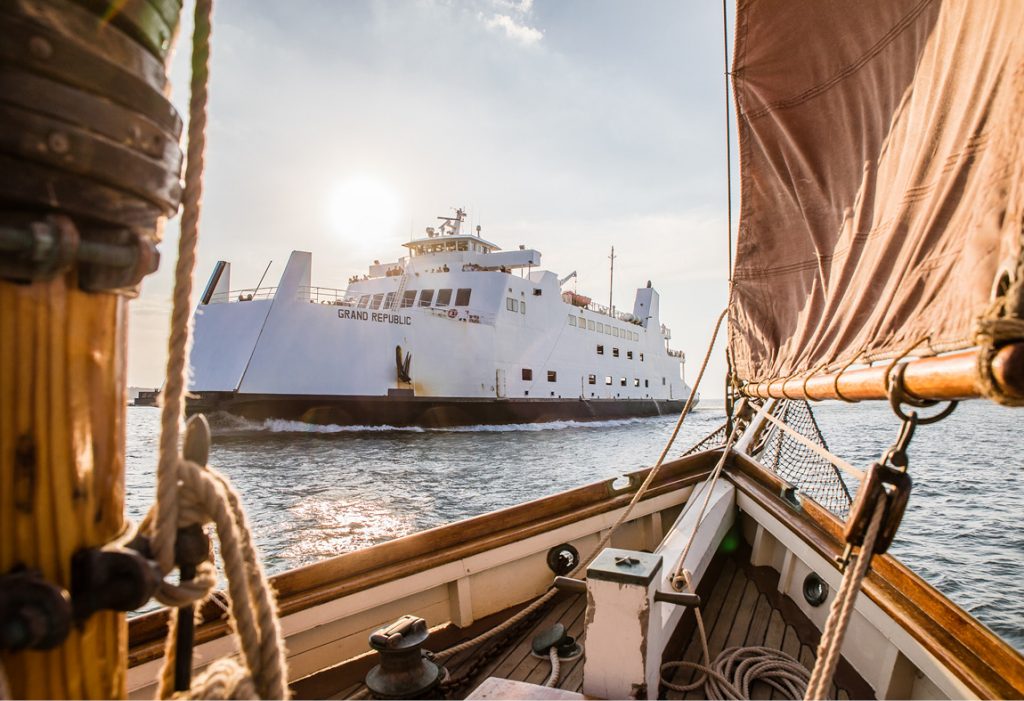
Crossing tacks with the cross-Sound ferry Grand Republic © Kerry Lukowski
Conversations will ensue. Tours of the ship given. Questions asked about the unique sailing ship. Brochures handed off to potential customers.
“She was built from plans of a 1920s design by William Atkins,” Murphy says.
In the early 20th Century, William Atkins designed recreational crafts and Ginny Marie is based on his plans for Chanty, a schooner built in 1927 in Huntington, NY by Chute & Bixby, according to its registry at Woodenboat.com.
“We’re like a sister ship,” Murphy explains.
So the design is old but Ginny Marie is merely based on the 1920s plans; she’s actually a 21st Century boat. A throwback, if you will. She had two other owners before Murphy, starting off life when the project was conceived in 1980 by a gentleman by the name of Dave Clarke who put her together almost piecemeal over two decades in New England. Back then she was called Winfield Lash. He finally set sail up and down the East Coast in 2000, heading as far as the Caribbean, according to local newspaper reports. Then she went to new owners in Mystic, CT with a new name, Crusader, where Murphy first saw her. She was for sale.
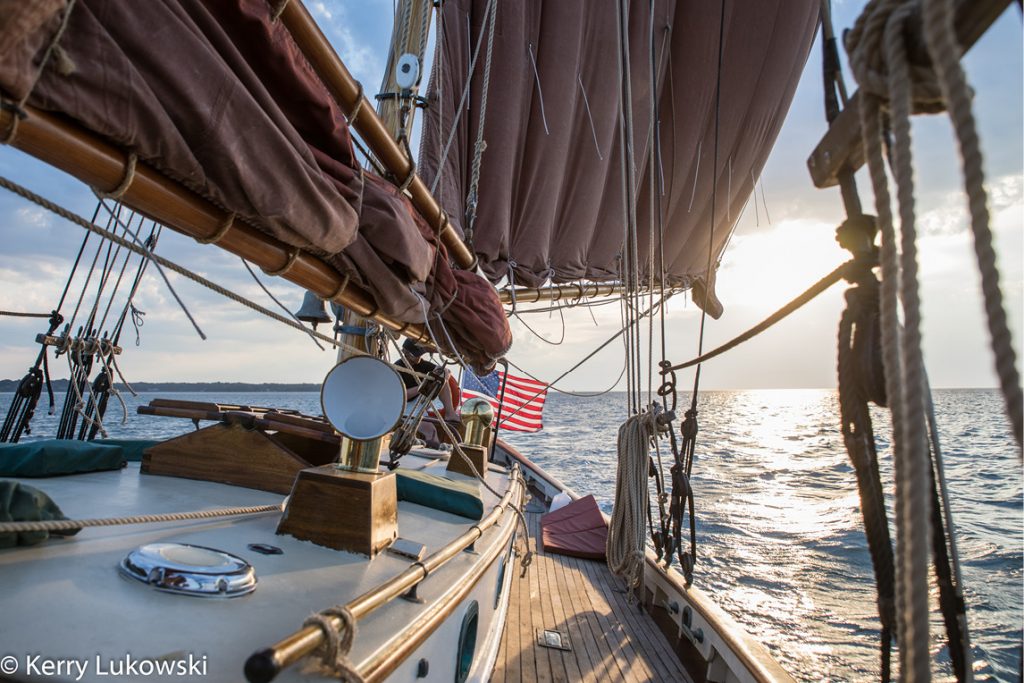
No electric winches here! The Ginny Marie brings history to life for guests, who are sometimes asked to help raise the sails. © Kerry Lukowski
Murphy had spent his youth poking around the North Shore of Long Island as a lad from Northport. He lived near, on, and in the waters of Long Island, first spending a couple of decades or so working oyster and clam boats starting in the era of bell bottoms and disco. Looking for something with a little more stability – literally and financially – he got his RN degree and put in his time as a nurse for Stony Brook Hospital until he retired and the sea called him back. He hopped up to Maine for a season, working as a mate on the Grace Bailey, a 123-foot wooden schooner run by Maine Windjammer Cruises. That’s about the time that Crusader née Winfield Lash came up for sale and Murphy knew where his next adventure was going to lead him.
Murphy had been speaking to the captain of the Amistad, a replica of the schooner on which the famous revolt occurred in 1839, who told him that the ship had been docked down in Port Jefferson for an educational trip and the village really wanted her to stay. Murphy hatched an idea and connected with Port Jefferson officials who supported the endeavor. And Crusader was the schooner to do the job.
“I knew right away it was the perfect boat,” Murphy said.
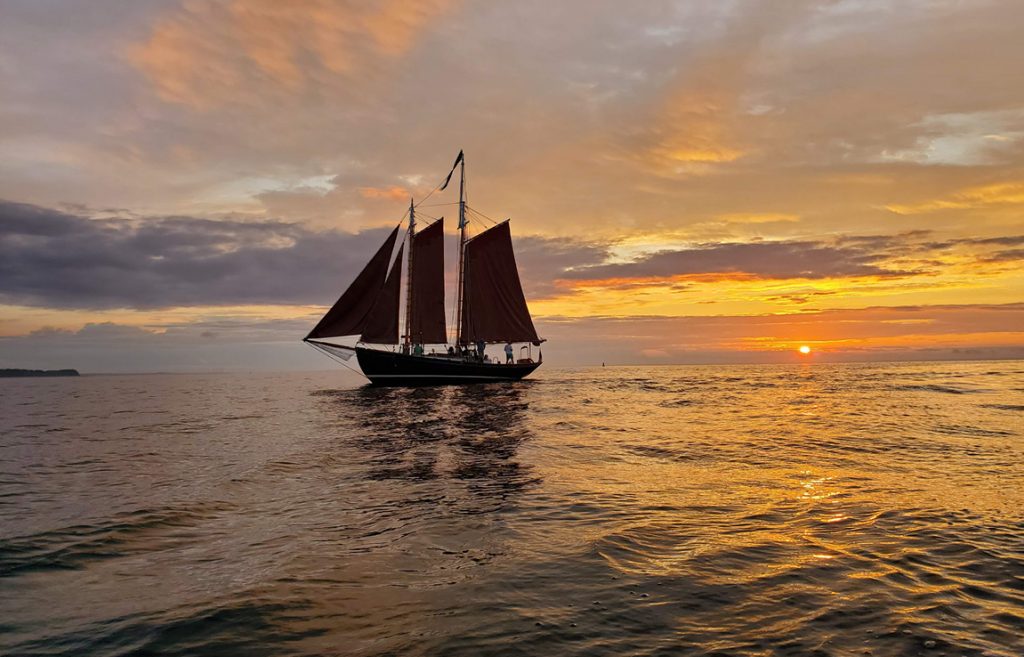
Sunset cruises aboard the Ginny Marie are particularly unforgettable. © Dave Hubbard
Ideally located on the Long Island Sound, Port Jefferson is a great stopover for sailors making a run in and out of New York City. With good anchorage, a protected harbor, and a proud maritime history, Port Jefferson offers food, fun, and shopping for day trippers whether they come by land or by sea. Murphy wanted to take advantage of that traffic in a way befitting the village’s character.
He acquired the vessel, renamed it for Virginia Marie, his partner in business and life, wife of 30 years, and mother of his two grown children. Then he launched a website to book charters and brought the Ginny Marie to Port Jefferson in 2020.
As with any story that began that year, the pandemic pushed off the inauguration of his business but eventually he was able to set sail that season – a little later than planned but taking advantage of pent up demand for outdoor activities and the isolation that sailing offers. He was able to open when others could not.
The Ginny Marie can take up to six passengers to enjoy a two-hour sail into the Long Island Sound and back. Sunset cruises last a bit longer and they are breathtaking as the sun sinks into the water affording boaters a painterly visage. Trips are booked online at ginnymarieschooner.com. Murphy will sail three or four times a day, seven days a week from May to October. Murphy can be heard to occasionally ask patrons if they have a little extra time when the wind is right and the hours are gliding by.
In the last two years, Ginny Marie’s profile has become iconic as social media is littered with posts and pictures of the unique wooden sailing ship, especially the distinctive sails, a reddish-brown coloration made from Duradon, a synthetic weave which, according to a manufacturing website, “resembles the oil-copper finish used on sailcloth in earlier times.”
“It’s very sun resistant,” said Murphy. “Very durable.”
No pulleys or winches to hoist the sails either. It’s all muscle.
“All sails are hoisted by hand,” he said. “That’s part of the charm of it.”
Murphy is a history buff, especially maritime history and working the Ginny Marie brings history to life, for the crew and the guests who are sometimes cajoled into helping raise sail. For him, the Ginny Marie is also a way to preserve the past and he loves the craftsmanship of the wooden ships.
“It reminds us of the way it was on Long Island when they were hauling goods on the Sound,” he said. “Schooners were the tractor trailers of the old days.”
To find out more about the Ginny Marie, log onto ginnymarieschooner.com. ■
Ginny Marie
Brings Old School Sailing to Long Island’s North Shore
- Crossing tacks with the cross-Sound ferry Grand Republic © Kerry Lukowski
- No electric winches here! The Ginny Marie brings history to life for guests, who are sometimes asked to help raise the sails. © Kerry Lukowski
- Sunset cruises aboard the Ginny Marie are particularly unforgettable. © Dave Hubbard


